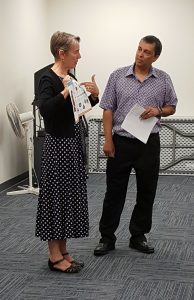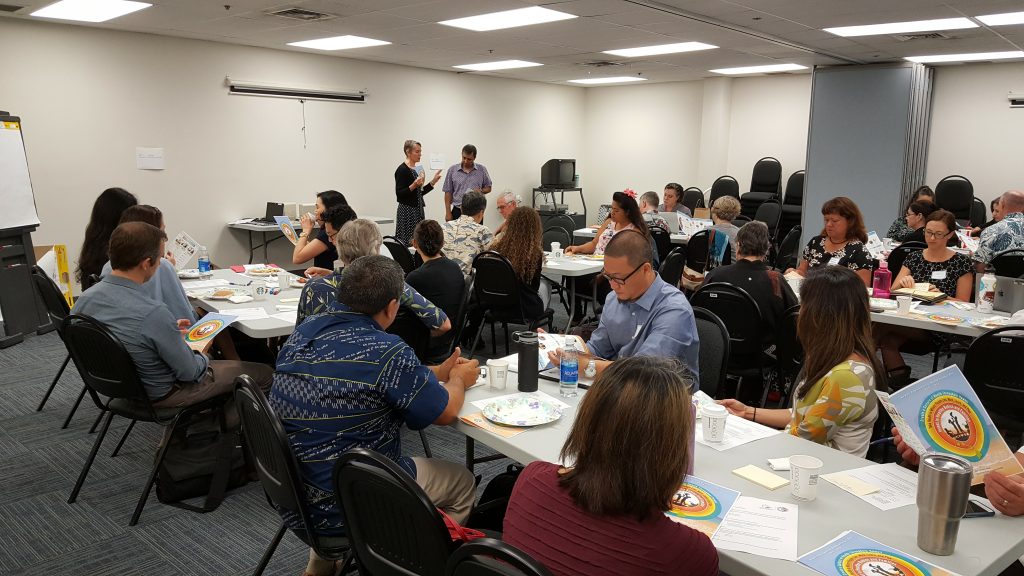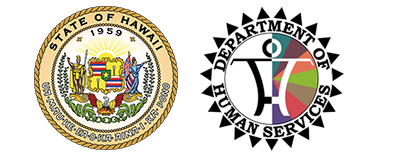Strategic Intention: The Catalyst for Something Historic
Posted on May 2, 2017 in Main‘Ohana Nui, the Catalyst for Something Historic
On a typical Wednesday morning in April, something “awesome,” “inspiring” and “historic” happened.
As has always been part of the master plan, ‘Ohana Nui would first be introduced to the DHS team and then rolled-out to the community as an expectation for non-profits that DHS funds. That is, these partner providers would be asked to apply ‘Ohana Nui principles to their work and show performance outcomes that reflect improved well-being for the whole family. We know this is no easy task in a perfect world – even more challenging in our imperfect world of shifting national politics and uncertain state funding.
So, on that April morning, DHS and the Federal Reserve Bank of San Francisco invited local non-profits and funders to come together and dialogue about how to increase the efficiency and impact of the work we do using ‘Ohana Nui as its framework. A stated assumption at the outset of this dialogue was that there would be no additional budget monies, and in fact, there is the real likelihood that there would be diminished support.

DOH Director Dr. Virginia Pressler and DHS Director Pankaj Bhanot share the collaborative work their departments have been doing.
We challenged ourselves and our partners to come together to find solutions.
Perhaps the most significant commitment to a productive partnership to support the families we serve is the one that already exists between the Department of Human Services and the Department of Health. DHS Director, Pankaj Bhanot, and DOH Director, Dr. Ginny Pressler, set the stage early in the meeting for what can be accomplished by working together. They discussed the many ways the two departments are already collaborating and applying ‘Ohana Nui principles, inspiring others in the room to build on the relationships that they have and to stretch to co-create new and innovative solutions to the challenges we are facing.
To spark the conversation among the partners in the room, former DHS clients shared their personal experiences in accessing the siloed services that we provide. What was evident through their stories was that the better they were able to understand and tap-into the various services we provide, the better their outcomes. The group of community leaders was forced to confront this uncomfortable truth.
Hearing these women’s stories, the providers and community partners acknowledged that applying ‘Ohana Nui makes sense – that it’s a “no brainer.” There was no argument that this is the right thing to do. And, they were also quick to understand how this multi-generation, whole-family approach gives families the best chance at breaking the generational cycle of poverty. So, buy-in for ‘Ohana Nui was natural. In fact, we could even envision and articulate what a more streamlined system – from application to eligibility, and then to delivery – would look like.

Leaders of community and provider partner organizations gathered with DHS, DOH and the Federal Reserve Bank of San Francisco.
The real challenge was figuring out how to get from where we are now in our various siloes to that elusive goal of an effective, streamlined system of programs and services that is client-focused and family-friendly.
I would like to say that at this meeting we were able to re-design a new and fabulous system that would allow us to fully realize all of the potential of ‘Ohana Nui, that we addressed all of the data-sharing challenges and we resolved the conflicting policies that are perceived to be inhibiting us from giving the families we serve the best chance to break the generational cycle of poverty. But, that wasn’t the case. Not on this day. While this community convening was a “who’s who” of our state’s non-profit leadership and private funding giants, even this group struggled with the next steps to take.
What did happen at this convening, though, was a visible and sincere commitment to work together as a group to figure this out. Even the notable participating leaders described this opportunity as nothing short of “awesome”, “inspiring” and “historic.”
These conversations, “a ha!” moments and challenges are not unlike what we face in our own divisions and staff offices as we work to realize the benefits of ‘Ohana Nui. And in this sense, perhaps it’s comforting to know that as a department we can be a model for the community, working together to figure it out for the benefit of the families we serve.
